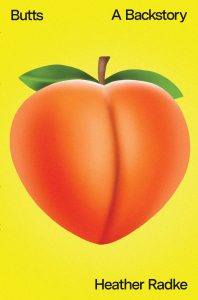Never skip a leg day, yes, but you probably shouldn’t skip a glute day either: the maximus gluteus is the biggest muscle in your body, and training your glutes can help with your posture, preventing back pain, and more!
I know I’m not supposed to judge a book by its cover and all, but just look at it! The moment I saw the cover on a list of recent releases, I knew I’d end up picking this up. It might seem an odd pick, but I’ve found I tend to be interested in microhistories, especially somewhat cheeky ones, as you may already be aware, so obviously I gravitated towards it the moment I saw it. In this age of Instagram and scrunch butt leggings*, not to mention post-2014, which was apparently Year of the Butt(?), it might sound a bit disingenuous to say that I hadn’t really given butts that much thought, but I went in thinking exactly this. As I started reading though, I slowly came to the realization that I had, in fact, absorbed more about butts than I’d realized without much conscious thought: Radke covered the ground I expected to be covered for a book on the female butt – how it’s been viewed throughout the ages in Western culture, the history & symbolism of this part of the body – but I also found myself wishing it were more filled out, in part because a lot of this ground has been covered elsewhere. Granted, I would still recommend this book for the convenience of having it all in one place, for anyone who is interested in learning about our fascination with the maximus gluteus, as the nature of that obsession (as a society, if not as individuals) has changed over the years.
While Radke got off to a strong start with the first few sections, with evolutionary biology**, Sarah Baartman, bustles, and eugenics as their focus, I personally found that the later chapters on contemporary celebrities fell flat: they tended to conclude just as I was thinking we were about to delve deeper, introductions to possible essays that could’ve started where they instead ended. I also agreed with a review from the Washington Post on the introduction, where I felt the anonymous quotes by women about their butts seemed completely unrelated to the material about to follow in the rest of the book: none of these other voices appeared to be linked whatsoever throughout, nor their thoughts expanded upon. I wouldn’t say that’s a huge detractor, but it certainly felt odd. Given all this, would I still recommend Butts to anyone who has an interest in the subject? For sure! The author herself admits what this book doesn’t cover – more importantly what it never intended to cover – and that it doesn’t purport to be the be all and end all on the history of butts, so with that in mind, it’s a fun and interesting look at the history of how butts have been viewed throughout the history of Western culture, plus conjectures on the role this muscle has played in our evolutionary (and cultural) history!
*I have some questions. Are these comfortable for working out in? (Is that even the purpose of them?) Do they facilitated wedgies, or the feeling of them? They just don’t look comfortable, but fashion over function I suppose?
**Not evolutionary psychology, for which “paleontologist Stephen Jay Gould described the thinking that undergirds these types of studies as the creation of “Just So Stories,” a reference to Rudyard Kipling’s book of children’s fables that offer fanciful explanations for traits like a leopard’s spots or a camel’s hump” (Radke, Butts. Feathers).
I’m not entirely sure where I’ve actually encountered the information on Sarah Baartman, essays on femininity and the representation of women in the media, cultural appropriation, and the like, but here are some other titles that might be of interest if you enjoyed Butts or are waiting for it to become available:
- Thick by Jessie McMillan Cottom, also available via Overdrive, which I’ve reviewed here
- You Play the Girl by Carina Chocono, also available on Overdrive through Markham
- Mediocre by Ijeoma Oluo, available on Overdrive
- Shrill by Lindy West
And for those of you who’re mostly just interested in the glutes, check out Glute Lab by Bret Contreras, a “glute training system” that will help you build “bigger, stronger, leaner, higher-performing glutes” (from description on Bibliocommons).

just popping in to say (Radke, Butts. Feathers) is perhaps the funniest parenthetical citation i’ve personally encountered!
Haha it’s certainly one of the more bizarre citations I’ve written!
For younger readers interested in this topic, I would recommend *Does a Bulldozer Have a Butt?* by Derick Wilder.
https://vaughanpl.bibliocommons.com/v2/record/S130C586708
The book takes a Gestalt approach to the ontology of where and how we perceive a butt. As a young girl asks variations of the same question on a walk with her father, butts emerge against the urban backdrop.
This sounds like a deeper philosophical take on the idea of butts than was even covered by Butts – I’m not sure Radke actually defined what a butt is (from memory)! That sounds like a fun “I Spy” book to read with younger readers, finding all the butts in the background. Thanks for sharing!